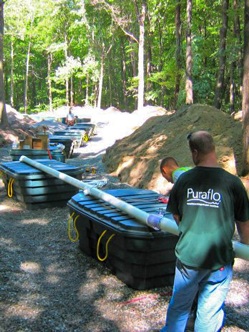Grand Rapids Herald Review (2006)
Nothing spells exciting like a new septic system. But for Bill Heig of Bowen Lodge on Lake Winnibigoshish, nothing could be more exciting than a chance to better the environment.
Heig is installing a new septic system, one he hopes will protect the environment around his second-generation resort, which he owns with his wife Gail.
The system uses a fairly new technology based on peat filtration, which itself is a byproduct of peat fuel operations in Ireland and while the phrase “new technology” conjures up images of big computers and fancy jargon, this system is as simple as pumping the waste water to the site and letting the peat do the rest.
Eric Larson of Septic Check, Inc., who was heading up the system’s construction, said the peat is an ideal medium to allow natural bacteria to treat wastewater. He said the peat gives the bacteria a place to live and have access to oxygen. The peat product used in the septic system is the byproduct of a peat pelletization process in Ireland in which peat is extracted from the country’s many bogs and turned into a burnable fuel source, Larson said.
Don Dewey, environmental services administrator for Itasca County, went to Bowen Lodge last week for an initial inspection of the system. He said the Heig’s resort is an example of what good conservation can be. “Bill is not under any order to do any of this,” Dewey said. “He wants to take a step ahead and update this system — not because the city or state is telling him he had to.”
Heig said he wants to show that commercial operations can be in the shoreline zone and still treat the environment with respect and care. “We’ve been getting a lot of grief lately, it seems like,” Heig said of his fellow resort owners around the state.
Barb McCarthy, a pollution control specialist with the Minnesota Pollution Control Agency, accompanied Dewey to the inspection of the new system. She praised the layout and design of the site.
At Bowen Lodge, the peat is contained in large tubs, or “pods,” which are then arranged in clusters , with two “branches” of pods moving away from each other. McCarthy noted that the nature of the clusters allowed Heig to avoid unnecessarily cutting down trees in the old-growth forest surrounding the resort. “And it’s nice that he’s pulling waste away from the lake,” she said.
McCarthy helps develop rules and does enforcement for the MPCA, but also has done research projects in the mid-1990s on new septic systems and projects.
Dewey said in the past, septic systems were about disposal. New systems, he said, are about long term protection. The peat system is known as a pretreatment system, whereby the wastewater is treated before it is sent to a drain field.
It was the perfect match for Heig, who said he wanted a system that was better for the environment and “I did a lot of research to try to find who had a lot of experience in pretreatment and clustered systems,” Heig said.
For that, he called Larson and Septic Check. Larson said that a peat system does cost a little more than a standard mound system — anywhere from 10 to 25 percent more, depending on the site — but costs less in the long run.
Fewer maintenance events and the longevity of the peat product help accomplish the economy of the system. And that is especially important for a family-run business like Heig’s. “It makes not only environmental but economic sense,” Heig said.
Business is not the only thing that runs in the Heig family. Respect for the environment does, too. Heig’s son, Jens, a junior in high school, takes part in River Watch, a program where high school students monitor waterways and analyze water samples.
A new septic system isn’t the only area of the resort to undergo a major environmental facelift. Bill Heig also spent a lot of time, money and effort to ensure his shoreline was safe from erosion and runoff.
Heig, with the help of the Minnesota Department of Natural Resources and the U.S. Forest Service, constructed a rip rap wall, keeping erosion at bay and providing a 4,500-foot-long buffer zone between the resort and Lake Winnibigoshish.
In the end, it comes down to respect for one’s surroundings and doing your part to ensure nature’s beauty is around for a long time, Heig said. “There are a lot of people who own lakeshore who don’t feel responsible to pass on lakeshore to future generations,” he said. And since his father, Bob Heig, passed the resort on to him in 1982, Bill Heig seems determined to keep that legacy.


